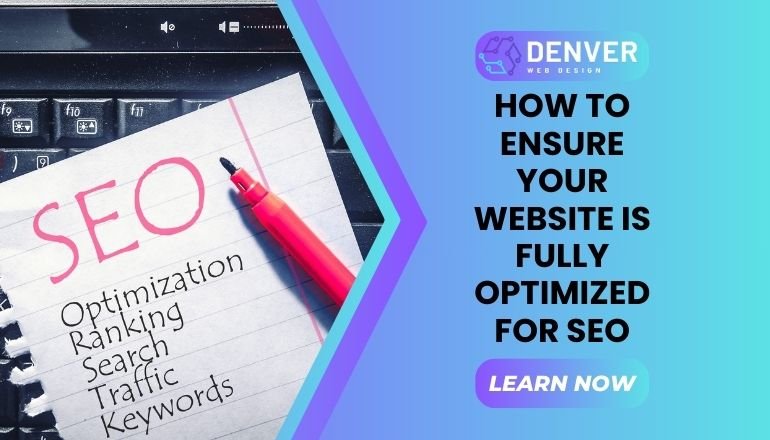
In today’s competitive digital landscape, having a website that is fully optimized for SEO is crucial for improving search engine rankings, increasing website traffic, and driving conversions. SEO (Search Engine Optimization) is the practice of enhancing a website’s visibility in search engine results, which can ultimately lead to more visitors and potential customers.
This article will cover how to optimize your website effectively, ensuring it ranks higher and provides a better user experience. At Web Design Denver, we specialize in designing and developing SEO-optimized websites that can help your business succeed online.
What is Website SEO Optimization?
Website SEO optimization refers to the process of improving various elements of your website to make it more appealing to search engines like Google, Bing, and Yahoo. The goal is to increase your site’s visibility in search engine results, making it easier for users to find your content when they search for relevant keywords. SEO optimization includes both on-page and off-page strategies, such as optimizing content, improving website structure, enhancing page speed, and building backlinks.
A critical component of website SEO optimization is ensuring that your website follows best practices in web design and web development. This can include mobile-first design, responsive web design, and focus on site speed, all of which contribute to a more user-friendly experience.
Why is SEO Optimization Essential for Your Website?
Improving your website’s SEO is essential for multiple reasons, including business growth, increased visibility, and higher conversion rates. Here’s why it’s so important:
- Increased Search Engine Visibility: A well-optimized website helps your business rank higher on search engines, making it more likely that your site will be found by potential customers.
- Improved User Experience: Search engines prioritize user-friendly websites. By focusing on SEO, you also improve your site’s usability, which enhances the user experience. A well-structured, easy-to-navigate website encourages users to stay longer and engage with your content.
- Higher Conversion Rates: A website that is optimized for SEO is not only easier for users to find, but it also provides them with a seamless browsing experience. This can lead to more conversions, whether you’re selling products, gathering leads, or promoting a service.
- Long-Term Growth: SEO is a long-term investment. With consistent optimization, you can continue to see positive results over time, unlike paid advertising which requires ongoing investment.
Key Features of SEO-Optimized Websites
When designing a website that is optimized for SEO, there are several key features to focus on. Here are some of the most critical components:
- Responsive Web Design: A responsive website design ensures that your site adjusts and displays properly across all devices, including desktops, tablets, and mobile phones. Google rewards mobile-friendly websites, making responsive design essential for SEO.
- Fast Loading Speed: Page speed is a ranking factor for Google. Websites that load faster provide a better user experience and are likely to rank higher. Optimize images, use proper caching, and minimize the use of heavy scripts to ensure faster load times.
- Content Optimization: Quality content is crucial for both SEO and user experience. Use relevant keywords strategically throughout your content, optimize your meta tags (titles, descriptions), and ensure your content is informative, engaging, and useful.
- Clear Site Structure: A well-organized website structure with clear navigation helps search engines crawl your website effectively. Ensure that your content is logically grouped, and use internal linking to guide users to relevant pages.
- SEO-Friendly URLs: URL structure plays an important role in SEO. Use simple, descriptive URLs that include relevant keywords and are easy for both users and search engines to understand.
Best Practices for SEO Optimization
- Keyword Research: Before optimizing your website, conduct thorough keyword research to identify the terms your target audience is searching for. Use tools like Google Keyword Planner or SEMrush to find high-volume, low-competition keywords and incorporate them naturally into your content.
- Mobile-First Design: Since a large portion of web traffic comes from mobile devices, it’s essential to adopt a mobile-first design approach. This means designing your website with mobile users in mind first, then scaling up for larger screens.
- Focus on User Experience (UX): Great UX and SEO go hand-in-hand. Improve the overall user experience by ensuring your website is easy to navigate, visually appealing, and quick to load.
- Optimize for Local SEO: For businesses targeting local customers, optimizing your website for local SEO is essential. This includes creating a Google My Business profile, getting local backlinks, and including location-based keywords on your site.
- Regular Content Updates: Search engines prefer websites that provide fresh, relevant content. Keep your website updated by adding new blog posts, articles, and product pages to stay competitive.
Common Mistakes to Avoid in SEO Optimization
- Overstuffing Keywords: While using keywords is important, overstuffing them into your content can lead to poor user experience and penalties from search engines. Keep keyword usage natural and relevant.
- Neglecting Technical SEO: Technical SEO aspects, such as ensuring proper use of header tags, setting up schema markup, and submitting your XML sitemap, should not be ignored. These elements help search engines understand your website better.
- Ignoring Mobile Optimization: Mobile optimization is a must. Websites that don’t function properly on mobile devices are penalized by Google’s mobile-first indexing.
- Low-Quality Backlinks: Backlinks are an important ranking factor, but acquiring low-quality or spammy backlinks can harm your website’s reputation. Focus on building high-quality, relevant backlinks from authoritative websites.
Conclusion: Key Takeaways
SEO optimization is crucial for ensuring that your website ranks higher in search engine results, attracts more visitors, and drives conversions. By implementing best practices such as responsive design, fast loading speeds, keyword optimization, and regular content updates, you can make sure your website is fully optimized for SEO success. At Web Design Denver, we specialize in building SEO-friendly websites that not only look great but also perform well in search rankings. Start optimizing your website for better search engine visibility and user experience today.






